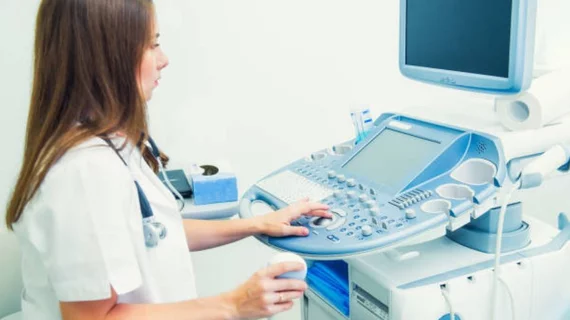Why point-of-care ultrasound may be radiology’s best bet against COVID
Most literature examining best practices for imaging patients with COVID-19 has focused on radiography and computed tomography, but research into point-of-care ultrasound is quickly gaining ground.
In fact, a recent gathering of a 10-expert panel in March concluded that POCUS offers many advantages over the other commonly used modalities, citing its mobility and ability to accurately track disease progression, among other reasons.
And in a pre-proof review article published May 13 in Clinical Radiology, a trio of clinicians hit on some of the aforementioned benefits, outlining point-of-care lung ultrasound’s diagnostic accuracy, clinical utility, and physical practicality in the intensive care unit.
Sagar Kulkarni, with the Medical Sciences Division of the University of Oxford, and colleagues performed a literature review of seven studies to reach their conclusions.
POCUS should be a priority
Prior to jumping into the diagnostic benefits of the modality, Kulkarni et al. pointed to some of its practical advantages. For example, because POCUS is a bedside test, patients don’t need to be moved to a different ward. This reduces the potential COVID exposure of healthcare staff, patients and visitors.
Additionally, the authors noted that the “common advantages of ultrasound still apply.” Namely that the test is cheap compared to other modalities, it doesn’t require radiation, and results are available in real-time.
Clinical findings using POCUS in COVID patients
Interstitial syndrome has been reported in patients infected with the new virus and is characterized by B lines between the ribs, apparent during imaging. Such lines are “common” in COVID-19, the authors noted, citing an outside study.
Ultrasound has proven to be more accurate than both chest radiography and auscultation at detecting this syndrome, suggesting such gains would also likely be apparent in patients sickened by the virus.
POCUS is also superior at detecting consolidation, which has been reported in more severe COVID cases
The authors report that ultrasound can also be used to exclude alternative diagnoses, including differentiating between acute respiratory distress syndrome and pleural effusion.
“There are several causes of hypoxia in the ICU,” the authors noted. “Distinguishing between them is important as it enables the correct treatment to be given.”
POCUS has a proven diagnostic accuracy of 93% for spotting pleural effusions, compared to 47% for chest radiography. And given that the condition is uncommon in COVID-19, if spotted, physicians may consider another diagnosis, such as bacterial pneumonia.
Barriers to using POCUS and how to overcome them
Ultrasound is an inherently user-dependent modality and, without proper training, could result in errors. While time-consuming in the short-term, over the long haul it is beneficial.
Decontaminating POCUS equipment may add more time to the workload of already exasperated physicians, but compared to portable x-ray or CT scanners, the process is much quicker.
Hospitals with ultrasound machines on hand can repurpose modalities from less-stressed units, such as outpatient clinics, and should re-deploy technologists and radiologists to COVID-19 examination areas.
“POCUS is an asset to hospitals as it minimizes nosocomial spread of the disease,” the researchers concluded. “In centers with lack of expertise in POCUS, radiologists are encouraged to provide this service.”

